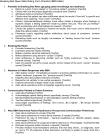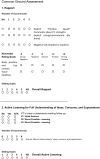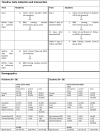Breaking bad news to patients with cancer: A randomized control trial of a brief communication skills training module incorporating the stories and preferences of actual patients
- PMID: 27876220
- PMCID: PMC5407084
- DOI: 10.1016/j.pec.2016.11.008
Breaking bad news to patients with cancer: A randomized control trial of a brief communication skills training module incorporating the stories and preferences of actual patients
Abstract
Objective: This study tested the effectiveness of a brief, learner-centered, breaking bad news (BBN) communication skills training module using objective evaluation measures.
Methods: This randomized control study (N=66) compared intervention and control groups of students (n=28) and residents' (n=38) objective structured clinical examination (OSCE) performance of communication skills using Common Ground Assessment and Breaking Bad News measures.
Results: Follow-up performance scores of intervention group students improved significantly regarding BBN (colon cancer (CC), p=0.007, r=-0.47; breast cancer (BC), p=0.003, r=-0.53), attention to patient responses after BBN (CC, p<0.001, r=-0.74; BC, p=0.001, r=-0.65), and addressing feelings (BC, p=0.006, r=-0.48). At CC follow-up assessment, performance scores of intervention group residents improved significantly regarding BBN (p=0.004, r=-0.43), communication related to emotions (p=0.034, r=-0.30), determining patient's readiness to proceed after BBN and communication preferences (p=0.041, r=-0.28), active listening (p=0.011, r=-0.37), addressing feelings (p<0.001, r=-0.65), and global interview performance (p=0.001, r=-0.51).
Conclusion: This brief BBN training module is an effective method of improving BBN communication skills among medical students and residents.
Practice implications: Implementation of this brief individualized training module within health education programs could lead to improved communication skills and patient care.
Keywords: Breaking bad news; Cancer; Common ground assessment; Communication skills training; Education; Empathy; Narrative; Objective structured clinical examination (OSCE); Qualitative; Stories.
Copyright © 2016 Elsevier Ireland Ltd. All rights reserved.
Conflict of interest statement
Figures
References
-
- Oken D. What to tell cancer patients - a study of medical attitudes. J Amer Med Assoc. 1961;175:1120–8. - PubMed
-
- Friedman HJ. Physician management of dying patients: an exploration. Psychiatry Med. 1970;1:295–305. - PubMed
-
- Novack DH, Plumer R, Smith RL, Ochitill H, Morrow GR, Bennett JM. Changes in physicians' attitudes toward telling the cancer patient. J Amer Med Assoc. 1979;241:897–900. - PubMed
-
- Fallowfield L, Jenkins V. Communicating sad, bad, and difficult news in medicine. Lancet. 2004;263:312–9. - PubMed
-
- Schmid Mast M, Kindlimann A, Langewitz W. Recipients' perspective on breaking bad news: how you put it really makes a difference. Patient Educ Couns. 2005;58:244–51. - PubMed
Publication types
MeSH terms
Grants and funding
LinkOut - more resources
Full Text Sources
Other Literature Sources
Research Materials




